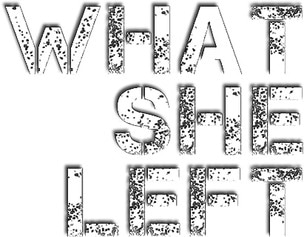What are we capable of when we have a fierce drive to live and there is nothing to lose?

What She Left is the fruit of a 2011 commission to write a performance piece based on materials in the then recently acquired Holocaust and Genocide-Related Research Collection. It included books original typescripts of the Nuremberg trials, and what they call ephemera: pamphlets; how-to uniform guides for SS officers, a belt buckle.
I spent hundreds of hours in the library basement room I called the cave. The librarian for the collection, called it the hole, short for Holocaust.
What She Left is a fictional amalgamation of stories from women who served as resistance fighters in the Polish forest during World War Two.
FROM WHAT SHE LEFT: She was smaller than me, thinner than me, at that time much younger than me, though she looked older than me because the moment she saw the child—sometimes she said it was “her daughter,” sometimes “her little sister, who knows? It could have been the neighbor’s child. It’s never been clear. The story is the moment she saw the little girl take the candy from the man standing at the door of the bus, the brightly colored bus the Germans drove through the streets to collect children because taking children, the strategists say, is the best way to destroy the body politic, the fabric of the community. Without children there is no tomorrow.
Accordion music from the open door, a handsome, smiling man waves, welcomes children onto the bus, promises a day of parks and pleasure and candy. She is peeling a potato, hears the music on the street, sees the child through the window take the candy, take the man's hand, step up onto the bus.
She runs from the house, down the stairs to the street. The door slams, the bus lurches. The woman jumps, clings to the back of the bus bumping through cobblestoned streets. The guard at the gate pries her off, throws her to the ground. Or maybe she throws herself at the feet of the man with the candy, clings to his trousers, pleads to take the child's place on the bus.
Don't worry,” he says, "your turn will come.”
I spent hundreds of hours in the library basement room I called the cave. The librarian for the collection, called it the hole, short for Holocaust.
What She Left is a fictional amalgamation of stories from women who served as resistance fighters in the Polish forest during World War Two.
FROM WHAT SHE LEFT: She was smaller than me, thinner than me, at that time much younger than me, though she looked older than me because the moment she saw the child—sometimes she said it was “her daughter,” sometimes “her little sister, who knows? It could have been the neighbor’s child. It’s never been clear. The story is the moment she saw the little girl take the candy from the man standing at the door of the bus, the brightly colored bus the Germans drove through the streets to collect children because taking children, the strategists say, is the best way to destroy the body politic, the fabric of the community. Without children there is no tomorrow.
Accordion music from the open door, a handsome, smiling man waves, welcomes children onto the bus, promises a day of parks and pleasure and candy. She is peeling a potato, hears the music on the street, sees the child through the window take the candy, take the man's hand, step up onto the bus.
She runs from the house, down the stairs to the street. The door slams, the bus lurches. The woman jumps, clings to the back of the bus bumping through cobblestoned streets. The guard at the gate pries her off, throws her to the ground. Or maybe she throws herself at the feet of the man with the candy, clings to his trousers, pleads to take the child's place on the bus.
Don't worry,” he says, "your turn will come.”

